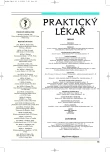Group B Streptococcus infection, screening, treatment - recommendation
Authors:
A. Měchurová
Authors‘ workplace:
Ústav pro péči o matku a dítě, Katedra gynekologie a porodnictví, Praha, ředitel doc. MUDr. J. Feyereisl, CSc.
Published in:
Prakt. Lék. 2006; 86(2): 92-94
Category:
Therapy
Overview
Group B Streptococcus infection (GBS, Streptococcus agalactiae) is asignificant cause of perinatal mortality and morbidity. Thus all pregnant women (withthe exception of those with a positive urine culture for GBS at any time during pregnancy) should undergo screening for streptococcus colonizationat 35 to 37 weeks of gestation with a vaginal culture from the lower third of the vagina. If the vaginal culture is positive, we do not treat the patient antepartum, but perform intrapartum prophylaxis (when membranes are ruptured or at the onset of uterine contractions) with the administration of intravenous antibiotics. Penicillin antibiotics are the first choice of treatment.
If the patient is penicillin-allergic with a low risk of anaphylaxis, we administer cephalosporins. If there is a high risk of anaphylaxis, we administer a lincosamide - clindamycin or a macrolide - erythromycin. It is most beneficial to administer the antibiotics more than 4 hours before delivery, otherwise the risk of colonization of the neonate dramatically increases. At delivery, the pediatrician must always be informed of maternal colonization.
Key words:
group B Streptococcus - Streptococcus agalactiae - screening – vaginal colonization - neonatal colonization - GBS infection - GBS sepsis.
Labels
General practitioner for children and adolescents General practitioner for adultsArticle was published in
General Practitioner

2006 Issue 2
Most read in this issue
- Group B Streptococcus infection, screening, treatment - recommendation
- IgA nephropathy – the most common primary glomerulonephritis worldwide
- Ergomentry under physical load
- The long pentraxin PTX3 – a new acute phase reactant
